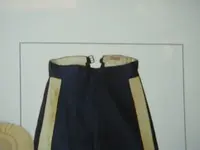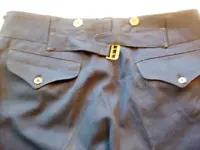You are using an out of date browser. It may not display this or other websites correctly.
You should upgrade or use an alternative browser.
You should upgrade or use an alternative browser.
Buckles?
- Thread starter sandraLee
- Start date
They are suspender buckles. They started being made in the mid 19th century. See if you can pull a manufacturer or date off of any.
Upvote
0
Red-Coat
Gold Member
Welcome to Tnet. A moderator may well move your post to a more appropriate section (this 'Help' section is for assistance on technical problems with the forum).
Cool old buckles. The top left one is a “PARIS SOLIDE” buckle. The information below is quoted from “A SELECTION OF CLOTHING BUCKLES FROM THE WARNER SITE, LIVINGSTON COUNTY, MICHIGAN” by Tim Bennett and published as:
http://warnerhomestead.com/yahoo_site_admin/assets/docs/Warner_Buckles.32893452.pdf
>>>Although fairly common, information regarding the production of “PARIS SOLIDE” buckles is sketchy at best. Alan and Gillian Meredith suggest in their 2011 book entitled Buckles that this style dates to the late nineteenth to early twentieth century. Others, such as the United Kingdom Detector Finds Database list a “PARIS SOLIDE” buckle with a similar timeframe, circa 1880-1910 (UKDFD 2007). As the name implies, the “PARIS SOLIDE” buckle was likely made in Paris, France and “Solide” is French for “solid”. Buckles with the “PARIS SOLIDE” imprint have been recovered in the US, United Kingdom, and Australia.
One of the earliest samples comes from the excavation of a Civil War era Confederate submarine, the H. L. Hunley, yielded a “PARIS SOLIDE” buckle inscribed with “G. C.”, a royal coat of arms, and “1860” belonging to Lt. Dixon (Hunter 2006). The Hunley was launched in July 1863 and was lost in February 1864. Other early examples including those inscribed with “1856” and “1857” were found by relic collectors on various sites including Civil War encampments. Only descriptions of the buckle as “PARIS SOLIDE” were provided by the relic hunters, however, no photographs were available to confirm the four digit numbers. The most recent sample, historically documented as part of a WWII era Red Cross cloth bandage used by Lance Sergeant Frederick Walter Dove while serving in Papua New Guinea and Australia dated circa 1942-1945. These two discoveries of “PARIS SOLIDE” buckles suggest production and worldwide distribution over several decades.
Several unassociated examples have been found to display a series of four numbers on the frame. It is unclear if the numbers refer to the year the buckle was produced or some type of style/model enumerator such as “1856”, “1857”, “1860”, “1869”, “1871”, “1872”, and “1886”. Other inscriptions besides “PARIS SOLIDE” include “G. & C.”, “BD&R”, “Exirac” and a royal coat of arms. The meanings behind “G. & C.”, “BD&R”, and “Exirac” are not currently understood.
Another documented example lists the words “BIRMINGHAM MADE” along with “PARIS” (UKDFD 2007, Meredith 2011). It is unclear if “BIRMINGHAM” refers to the manufacturer name or location, however, Birmingham, England gained prominence as a manufacturing powerhouse during the industrial revolution and became well known for making all sorts of metallic objects (especially brass, copper, and steel) including buttons, buckles, and locks (Beresford 1960).
Professional, well-documented archaeological and historical samples, especially those attributed to a specific person ranging from the Civil War (Lt. Dixon on the H. L. Hunley) to WWII (Lance Sergeant Frederick Walter Dove of Australia) suggest that the time frame is significantly wider than previously thought, as early as 1860 (and possibly a few years earlier) to as late as the mid-1940s, a span of over eighty years. It also appears likely that the four-digit number refers to the year of manufacture as interpretation as a date appears to match contemporaneously with the age of sites and the artifacts found along with it.
This type of buckle was used to provide tension adjustment on the rear straps of men’s waistcoats (vests) to provide a smooth closed front behind the jacket opening (UKDFD 2007, Meredith 2011). An intact example is found on the back of a suit waistcoat made by James Neal, of Cambridge, England dated to 1906 (Manchester Art Gallery 2009). Other applications of the buckle include use for men’s pants and as well as women’s clothing such as corsets (Meredith 2011).<<<
Cool old buckles. The top left one is a “PARIS SOLIDE” buckle. The information below is quoted from “A SELECTION OF CLOTHING BUCKLES FROM THE WARNER SITE, LIVINGSTON COUNTY, MICHIGAN” by Tim Bennett and published as:
http://warnerhomestead.com/yahoo_site_admin/assets/docs/Warner_Buckles.32893452.pdf
>>>Although fairly common, information regarding the production of “PARIS SOLIDE” buckles is sketchy at best. Alan and Gillian Meredith suggest in their 2011 book entitled Buckles that this style dates to the late nineteenth to early twentieth century. Others, such as the United Kingdom Detector Finds Database list a “PARIS SOLIDE” buckle with a similar timeframe, circa 1880-1910 (UKDFD 2007). As the name implies, the “PARIS SOLIDE” buckle was likely made in Paris, France and “Solide” is French for “solid”. Buckles with the “PARIS SOLIDE” imprint have been recovered in the US, United Kingdom, and Australia.
One of the earliest samples comes from the excavation of a Civil War era Confederate submarine, the H. L. Hunley, yielded a “PARIS SOLIDE” buckle inscribed with “G. C.”, a royal coat of arms, and “1860” belonging to Lt. Dixon (Hunter 2006). The Hunley was launched in July 1863 and was lost in February 1864. Other early examples including those inscribed with “1856” and “1857” were found by relic collectors on various sites including Civil War encampments. Only descriptions of the buckle as “PARIS SOLIDE” were provided by the relic hunters, however, no photographs were available to confirm the four digit numbers. The most recent sample, historically documented as part of a WWII era Red Cross cloth bandage used by Lance Sergeant Frederick Walter Dove while serving in Papua New Guinea and Australia dated circa 1942-1945. These two discoveries of “PARIS SOLIDE” buckles suggest production and worldwide distribution over several decades.
Several unassociated examples have been found to display a series of four numbers on the frame. It is unclear if the numbers refer to the year the buckle was produced or some type of style/model enumerator such as “1856”, “1857”, “1860”, “1869”, “1871”, “1872”, and “1886”. Other inscriptions besides “PARIS SOLIDE” include “G. & C.”, “BD&R”, “Exirac” and a royal coat of arms. The meanings behind “G. & C.”, “BD&R”, and “Exirac” are not currently understood.
Another documented example lists the words “BIRMINGHAM MADE” along with “PARIS” (UKDFD 2007, Meredith 2011). It is unclear if “BIRMINGHAM” refers to the manufacturer name or location, however, Birmingham, England gained prominence as a manufacturing powerhouse during the industrial revolution and became well known for making all sorts of metallic objects (especially brass, copper, and steel) including buttons, buckles, and locks (Beresford 1960).
Professional, well-documented archaeological and historical samples, especially those attributed to a specific person ranging from the Civil War (Lt. Dixon on the H. L. Hunley) to WWII (Lance Sergeant Frederick Walter Dove of Australia) suggest that the time frame is significantly wider than previously thought, as early as 1860 (and possibly a few years earlier) to as late as the mid-1940s, a span of over eighty years. It also appears likely that the four-digit number refers to the year of manufacture as interpretation as a date appears to match contemporaneously with the age of sites and the artifacts found along with it.
This type of buckle was used to provide tension adjustment on the rear straps of men’s waistcoats (vests) to provide a smooth closed front behind the jacket opening (UKDFD 2007, Meredith 2011). An intact example is found on the back of a suit waistcoat made by James Neal, of Cambridge, England dated to 1906 (Manchester Art Gallery 2009). Other applications of the buckle include use for men’s pants and as well as women’s clothing such as corsets (Meredith 2011).<<<
Upvote
3



Upvote
0
TheCannonballGuy
Gold Member
- Feb 24, 2006
- 6,542
- 13,069
- Detector(s) used
- White's 6000, Nautilus DMC-1, Minelab
- Primary Interest:
- Relic Hunting
As Red-Coat's excellent documentation proves, the buckle at upper left in your photo is an antique vest waist-adjuster strap or pants waist-adjuster strap buckle. Here are two photos to show you what I mean by "pants waist-adjuster strap." Ones marked Paris Solide can date from the 1860s into the early 20th-Century.
Attachments
Upvote
2
Top Member Reactions
-
 2586
2586 -
 1145
1145 -
 1051
1051 -
 905
905 -
 887
887 -
 849
849 -
 803
803 -
 694
694 -
 642
642 -
 544
544 -
 490
490 -
 475
475 -
 474
474 -
 464
464 -
 462
462 -
O
441
-
 423
423 -
 392
392 -
 381
381 -
 363
363
Users who are viewing this thread
Total: 2 (members: 0, guests: 2)







